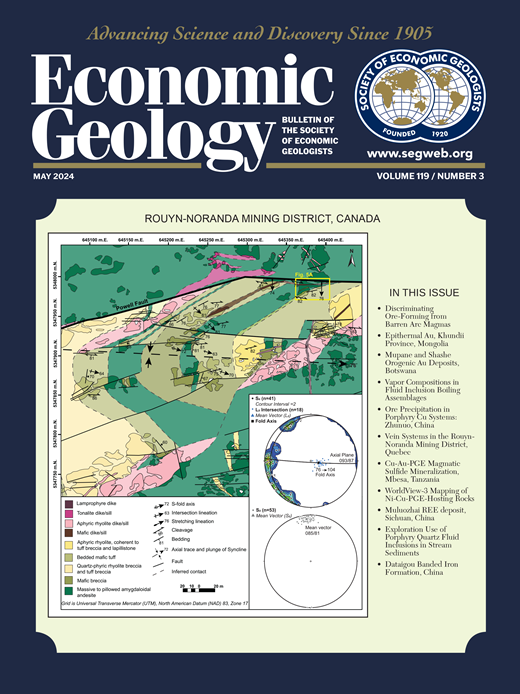Combined X-Ray Computed Tomography and X-Ray Fluorescence Drill Core Scanning for 3-D Rock and Ore Characterization: Implications for the Lovisa Stratiform Zn-Pb Deposit and Its Structural Setting, Bergslagen, Sweden
IF 5.5
1区 地球科学
Q1 GEOCHEMISTRY & GEOPHYSICS
引用次数: 0
Abstract
We present the results of a pilot study that integrates automated drill core scanning technology based on simultaneous X-ray computed tomography (XCT) and X-ray fluorescence (XRF) analyses to provide high-spatial-resolution (<0.2 mm) information on 3-D rock textures and structures, chemical composition, and density. Testing of its applicability for mineral exploration and research was performed by scanning and analyzing 1,500 m of drill core from the Paleoproterozoic Lovisa stratiform Zn-Pb sulfide deposit, which is part of a larger mineral system also including Cu-Co and Fe-(rare earth element) mineralization, hosted by the highly strained West Bergslagen boundary zone in south-central Sweden. The obtained scanning data complements data derived from structural field mapping, drill core logs, and chemical analysis as well as from multiscale 3-D geologic modeling at Lovisa. Data integration reveals macro- and mesoscopic folding of S0/S1 by asymmetric steeply SE-plunging F2 folds and N-striking vertical F3 folds. Stretching lineations, measured directly from the scanning imagery, trend parallel to F2 fold hinges and modeled ore shoots at the nearby Håkansboda Cu-Co and Stråssa and Blanka Fe deposits. The textural character of the Lovisa ore zones is revealed in 3-D by XCT-XRF scanning and highlight remobilization of Zn and Pb from primary layering into ductile and brittle structures. The downhole bulk geochemical trends seen in scanning and traditional assay data are generally comparable but with systematic variations for some elements due to currently unresolved XRF spectral overlaps (e.g., Co and Fe). The 3-D deformation pattern at Lovisa is explained by D2 sinistral transpression along the West Bergslagen boundary zone in response to regional north-south crustal shortening at ca. 1.84–1.81 Ga. Local refolding was caused by D3 regional east-west crustal shortening resulting in dextral transpression along the West Bergslagen boundary zone, presumably at ca. 1.80–1.76 Ga. Based on polyphase ore textures and modeled ore shoots aligned to F2 fold hinges, we postulate that D2 and D3 transpressive deformation exerted both a strong control on ore remobilization and the resulting orebody geometries at Lovisa and neighboring deposits within the West Bergslagen boundary zone. We conclude that the combined XCT-XRF drill core scanning technique provides a valuable tool for 3-D ore and rock characterization, generating continuous downhole data sets, with the potential for increasing precision and efficiency in mineral exploration and mining.联合x射线计算机断层扫描和x射线荧光岩心扫描三维岩石和矿石表征:Lovisa层状铅锌矿床及其构造背景的意义,Bergslagen,瑞典
我们展示了一项先导研究的结果,该研究集成了基于同步x射线计算机断层扫描(XCT)和x射线荧光(XRF)分析的自动岩心扫描技术,可提供三维岩石纹理和结构、化学成分和密度的高空间分辨率(<0.2 mm)信息。通过扫描和分析来自瑞典中南部高度紧张的West Bergslagen边界带的古元古代Lovisa层状Zn-Pb硫化物矿床的1500米钻芯,测试了其在矿产勘探和研究中的适用性,该矿床是一个更大的矿物系统的一部分,还包括Cu-Co和Fe-(稀土元素)矿化。获得的扫描数据补充了来自构造场测绘、岩心测井、化学分析以及Lovisa多尺度三维地质建模的数据。数据综合表明,S0/S1的宏观和介观褶皱主要由不对称的陡向se倾F2褶皱和向n方向的垂直F3褶皱构成。从扫描图像中直接测量到的拉伸线走向平行于F2褶皱铰链,并在附近的h kansboda铜钴矿床和stramatssa和Blanka铁矿中模拟了矿床。通过XCT-XRF扫描,揭示了Lovisa矿带的三维构造特征,并强调了锌和铅从原生层状向韧性和脆性结构的再活化。在扫描和传统分析数据中看到的井下整体地球化学趋势通常具有可比性,但由于目前未解决的XRF光谱重叠,某些元素(例如Co和Fe)存在系统变化。Lovisa的三维变形模式可以用沿西Bergslagen边界带的D2左旋变形来解释,这是对约1.84-1.81 Ga区域南北地壳缩短的响应。局部再褶皱发生于约1.80 ~ 1.76 Ga,是由D3区域东西地壳缩短导致的沿西贝格斯拉根边界带右向逆压引起的。基于多相矿体结构和向F2褶皱铰方向排列的模拟矿芽,我们认为在Lovisa和West Bergslagen边界带附近的矿床中,D2和D3逆压变形对矿石再活化及其形成的矿体几何形状具有很强的控制作用。我们得出的结论是,XCT-XRF岩心扫描技术为三维矿石和岩石表征提供了一种有价值的工具,可以生成连续的井下数据集,具有提高矿产勘探和开采精度和效率的潜力。
本文章由计算机程序翻译,如有差异,请以英文原文为准。
求助全文
约1分钟内获得全文
求助全文
来源期刊

Economic Geology
地学-地球化学与地球物理
CiteScore
10.00
自引率
6.90%
发文量
120
审稿时长
6 months
期刊介绍:
The journal, now published semi-quarterly, was first published in 1905 by the Economic Geology Publishing Company (PUBCO), a not-for-profit company established for the purpose of publishing a periodical devoted to economic geology. On the founding of SEG in 1920, a cooperative arrangement between PUBCO and SEG made the journal the official organ of the Society, and PUBCO agreed to carry the Society''s name on the front cover under the heading "Bulletin of the Society of Economic Geologists". PUBCO and SEG continued to operate as cooperating but separate entities until 2001, when the Board of Directors of PUBCO and the Council of SEG, by unanimous consent, approved a formal agreement of merger. The former activities of the PUBCO Board of Directors are now carried out by a Publications Board, a new self-governing unit within SEG.
 求助内容:
求助内容: 应助结果提醒方式:
应助结果提醒方式:


